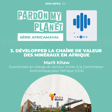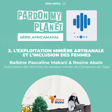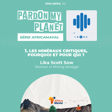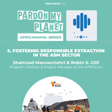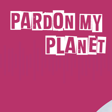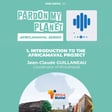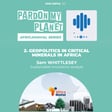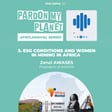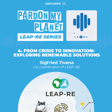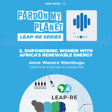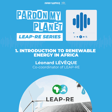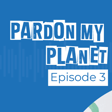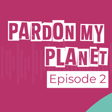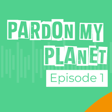Become a Creator today!Start creating today - Share your story with the world!
Start for free
00:00:00
00:00:01

Transforming recycling for a sustainable textile industry
The fashion industry has a huge impact on our planet, from the waste it generates to the resources it consumes. Fortunately, change is happening. Recycling, innovation, and collaboration across the supply chain are key to transforming the way we produce, manage textiles. Today our guest is Jyotsna Gopinath, innovation analyst at Fashion For Good, a global initiative dedicated to transforming the fashion industry into a more sustainable and circular system.
Transcript
Fashion's Environmental Impact and Potential for Change
00:00:09
Speaker
Hello, and welcome to Pardon My Planet podcast. I'm Angela, your host, and today we're exploring the challenges and opportunities of recycling in the textile industry. The fashion industry has a huge impact on our planet, from the waste it generates to the resources it consumes.
Sustainable Practices with Jotzna Gopinap
00:00:28
Speaker
Fortunately, changes happening. Recycling, innovation, and collaboration across the supply chain are key to transforming the way we produce and manage textiles.
00:00:38
Speaker
Today we welcome Jotzna Gopinap, Innovation Analyst at Fashion for Good, a global initiative dedicated to transforming the fashion industry into a more sustainable and circular system. Hello Jotzna and welcome. Hi, thank you for having me. And thank you for being here.
Understanding Textile Waste
00:00:57
Speaker
The textile industry is responsible for approximately 10% of global carbon emissions, but it also produces a lot of waste.
00:01:06
Speaker
Can you tell us a bit more about the current textile waste landscape? Yes, of course I can. and In order to understand the textile waste landscape, it's also important to zoom out and understand the textile value chain. right How we go from raw materials all the way to creating garments that then come to a consumer and then end up as textile waste potentially.
Synthetic vs Natural Fibers Debate
00:01:27
Speaker
and There's waste generated throughout this value chain. right so From raw materials to creating fabrics to creating garments, um all of those steps have waste created. And we typically call those waste sources post-industrial, so fabric offcuts, for example.
00:01:44
Speaker
or pre-consumer, which are fully assembled garments that never make it to the consumer, but can be considered waste for whatever reason. And then once the consumer uses it after the use phase, we aggregate a whole different type of waste called post-consumer waste, right? And this is a little bit different than the production waste that um ah typically comes out of the value chain. And there's different fibers used in our garments. So we have synthetic fibers like polyesters, nylons, elastanes, et cetera. Those typically come from petrochemical sources. And then we have natural fibers like cotton, wool, and other fibers found in nature, right? And the ways we can handle those types of wastes are different.
Exploring Recycling Methods
00:02:27
Speaker
um And this linear value chain needs to become circular again, otherwise we're just gonna keep creating more and more and more waste. And recycling is one way to achieve this. But the recycling options that exist for synthetic fibers
00:02:40
Speaker
and natural fibers are very different. And there's a lot of really interesting innovation in this space as well. We're going to talk about this in ah in a second. How do you concretely do? Because we don't talk here about secondhand. We talk about really fiber recycling. And just as you said, there is a lot of different type of textiles out there, right? So how do you sort everything out to make it recyclable?
Challenges in Textile Waste Management
00:03:05
Speaker
Yes, exactly. So not only are there you know different types of waste that come out through the value chain and through the consumer, right? But there's also different compositions of waste too. And the waste supply chain itself starts at the aggregation and collection of waste, whether it be you know from the production waste or whether it be from the consumer and how those are aggregated and sorted are very different. And then we have you know the options for after that, which is once we have all that waste, what do we do with it?
00:03:35
Speaker
And recycling is a really great solution for that. And there's some different types of recycling out there. Today, we're mostly going to focus on chemical recycling solutions, but mechanical recycling exists. So as the name suggests, that's using mechanical action to um most, let's say, most commonly chop up the fibers and then spin them into new yarns to simplify it down. um There's also thermo mechanical recycling, which, you know, takes more synthetic sources and then can extrude those into new fibers.
00:04:04
Speaker
um But chemical recycling really is the use of chemicals and different solvents to change the the molecular makeup sometimes of the of the fibers itself and really break it down to a polymer, monomer level, like really the the original building blocks that make up fibers, purify them and then create new products from there. And that's a relatively new technology um that we'll be discussing today. but this is These are kind of the approaches we take into managing the waste supply chain for textiles. And there's a lot of work to be done for sure, but there's a lot of promise on the horizon.
The T-Rex Project: A Circular Approach
00:04:40
Speaker
that's ah That's great. And for this, you are working on a project called T-Rex. It's a European Union funded project dedicated to post-consumer textile waste and how to make it more circular, just as you just said. And on the website of the project, I was surprised to read that only 2% of post-consumer textiles in ah Europe, I diverted to fiber to fiber recycling.
00:05:07
Speaker
Exactly. How so? And what are the barriers or challenges that explain such a low number? Yeah, exactly. um there's There's quite a few barriers, but you just pointed out a great one, which is a disjointed waste supply chain, right? um We're still trying to figure out what it means to collect and sort this waste on a municipal level, just post-consumer in general. I think Sourcing waste from factories, that makes sense, right? and The cuts come off and then those can be diverted to recyclers um for them to use. And that that's been going on for a while, right? But this whole post-consumer aspect of it, which the T-Rex project really focuses on is how do we collect municipal textile waste coming from the consumer, divert it accordingly to the correct streams needed to recycle it?
00:05:54
Speaker
Um, and then, you know, create new products out of that. And there's such complexity, not only in the waste supply chain, but also in the textile waste itself. Right. Um, if we look at our clothes and whoever's listening to this, please take a look at your clothing tag. There's at least two different types of fiber types in any, in any old garment, you know, and then on top of that, art clothes also have dyes, finishes, additives, everything to make.
00:06:20
Speaker
a polymer or a natural fiber comfortable to wear has been added to our clothes, all of that has to be undone on top of making sure that there's enough of the main output, whether it be polyester, cellulose, or nylon, to actually recycle it into something new, right? So there's so many so many checks that need to go through in order for textile waste to be a suitable feedstock for a recycling process, right? And then finally,
00:06:48
Speaker
There needs to be a lot of funding and investment to scale chemical recycling, right, not just from an R and&D perspective, but the actual building of plants and building of machinery and um implementing these solutions and different types of business models that requires cash flow. And so these three, you know, coming together, these barriers of a disjointed waste supply chain, the complexity of the textile waste itself, and then the need for funding. All of these are really key to unlocking chemical recycling going to a commercial scale and being an actual viable solution for textile waste. Are there also legislative or maybe consumer related barriers as well?
EU Regulations and Sustainable Practices
00:07:29
Speaker
Yes, for sure. And right now, with you know there's upcoming regulations from the EU right now that's basically going to push the industry into being like, we have to develop these technologies, right? And that's just everything in the waste supply chain, right? In order for recycling to scale textile waste collection and aggregation, that needs to become more efficient.
00:07:49
Speaker
The sorting of textile waste needs to become more automated and analytical so that we can actually determine textile waste complexity and profiles of that complexity. And then finally, the recycling itself can scale, right? Everything has to line up. And this push from legislation to essentially get it together and assess what we're doing with our textile waste is going to mean that each step of the waste supply chain is going to scale up. And and I can give an example to um Yes, PR. So that's the eco design for sustainable products regulation. It's a key initiative under the EU Green Deal that aims to make sustainable products the norm in the EU, right? That's big that's a big challenge. um And basically, it's setting out to set out these comprehensive requirements that focus on
00:08:37
Speaker
improving product durability, so the life cycle of the product itself lasts longer, so it can't become waste as fast. um But also reusability, repairability, right? These are also important. If your garment, you know, over time needs repairability, it should be easier to do, right? Yeah, absolutely. To become waste. And then finally, recyclability. And this comes with this mandated increased use of recycled content across industries, right? Textiles being our focus today.
00:09:05
Speaker
So this is an example of a legislative driver. hey Awesome. Thank you for this ah this ah example, a very enlightening example. And how does the TIRAC projects hopes to address and overcome those challenges as well?
Building a Circular Recycling Blueprint
00:09:19
Speaker
Right. So the T-Rex project is unique because it involves 13 players from across the entire value chain that we went through, you know, earlier in our discussion, which is every step of the value chain needs someone represented in order for us to turn it from linear to circular. And the T-Rex project really does that. And the goal is demonstrating a potential scalable solution for textile to textile recycling, you know, for this project, right? All 13 of us coming together and proving, can we create this blueprint?
00:09:49
Speaker
for what real post-consumer textile to textile recycling can look like. And that's the goal of our project. um And basically, we go everywhere from the aggregation all the way into new product creation. um So we have sorters, collectors, um preprocessors of the feedstock, and then the recyclers itself, spinners, and then garment manufacturing, and then also organizations like Fashion for Good that look at You know the digitization needs of the supply chain and the techno economic models um that that are necessary in order to scale.
00:10:24
Speaker
Textile to textile recycling. We also have an LCA happening through the project, both a LCA led by Qantas and also a social LCA too to understand the social implications. So the project really aims to look at textile to textile recycling from every possible angle, not just a circular value chain, but what sits above the value chain, right? Which is all these enabling factors to making sure that it can exist.
00:10:47
Speaker
And so you are also, I guess, studying the collaboration between all those actors and how they interact with each other, right? Exactly. And so the end product, kind of what we're trying to achieve with this is a harmonized EU blueprint and business opportunities for closed loop sorting and recycling.
00:11:06
Speaker
of municipal and household textile waste, right? And it's a three year project. So we really like dove in to every aspect of it and been working over the course of three years to just demonstrate sustainable and economically feasible examples of what textile to textile recycling can look like with each actor in the value chain involved, right? So it's, it's truly a collaborative effort that we've all been working on for three years and I have to say I really enjoy working um with all of them because I learned so much from talking for example to a spinner and the differences between spinning let's say a recycled um source versus a petrochemical virgin source and just small little learnings like this translate up and down the supply chain and truly make it circular because the information truly flows through all of us you know um and it's been it's been a great learning opportunity for our consortium and our hope is then
00:12:00
Speaker
to then expand that learning to the EU and
Educating the Public on the Circular Economy
00:12:02
Speaker
beyond. There is also an aspect in the T-Rex projects that I find very interesting is the citizen engagement. Can you maybe further elaborate on this aspect of the project? Yeah, this is this is one of the coolest things I think about the T-Rex project because yes, it's really important to get the value chain together, look for solutions. but That means nothing if we don't educate the the general public about their hand right in this in this challenge. And so the EU specifically has highlighted culture as one of those key challenges to adoption of a circular economy. And I think the beauty of that is education. Education changes minds and hearts and and makes people passionate about their role in finding a solution. right So the T-Rex project
00:12:46
Speaker
has the citizen engagement and communication arm to really tap into that. And, you know, often communications around a project like this can be really technical and maybe not super accessible or really fun to hear about from the general public. So how do we take what we've learned and this technical stuff that we're learning as we go and then make it into accessible storytelling and education to actually engage citizens. right That's how we change minds. Within the project, researchers from the consortium member, Alto University, um there's they've planned so many various citizen engagement activities in Finland, France, and the Netherlands over the course of the project so far. and Some of those activities include workshops on extending the lifetimes of
00:13:31
Speaker
textile items through repair. The repair workshop was super fun. um There was also an upcycling component and a redesign component as well. There's also been clothing swap events. We hosted one at Fashion for Good, and I i gave some items in there. So whoever got my sweater, you're welcome.
00:13:47
Speaker
yeah Also, we've done visits to sorting centers, so really understanding how textile sorting actually works, because for the average consumer, and including me, before I came into this role, I didn't realize the actual intricacies and logistics of sorting waste, right? um And there was also this really fun textile race for um for young l um young children in school for collecting unused textile items in their local communities and really understanding their role.
00:14:16
Speaker
in textile waste collection and all of this educational material you know for consumers and and um for the industry. The goal for this project is really can we engage citizens across you know across the value chain and across just the consumption base to to understand their hand in the the waste challenge. And I think that that aspect of the project is really exciting.
Consumer Role in Recycling Solutions
00:14:40
Speaker
And it makes a perfect bridge also with the innovation, because the innovation in itself would not be ah would not go very far if there was no interest or no citizen engagement, right? Exactly. Not at all. And the point of innovation is to, honestly, in my opinion, make lives and communities better.
00:14:58
Speaker
And so I think it's it's great to be both someone who is you know an engineer and someone who cares about sustainable innovation, but I'm also just a citizen like the rest of us. you know And so being someone who's both a consumer and a citizen and also kind of sees the inner workings of this, I see how important it is for buy-in to really cool new innovation. it really has to It really has to be communicated the impact it can have on the average person. right and so then there's a buy in from both ends. And that's how we solve this textile waste challenge, right? Educate the average person, their hand in creating, sorting and diverting textile waste. And then also educate them on the solutions that exist and hopefully get them inspired to be involved.
00:15:43
Speaker
um Yeah. This vision you have about the industry and the consumers as well who are ah more aware of the challenges around textile recycling. What is your vision for the future of textile recycling? And in a second time, a second question would be, what can listeners do, whether where they they are inside industry or they are consumers, what can they do to support this transition?
Future of Recycling Technologies
00:16:13
Speaker
Right. So first question, what's the future? I think so. My background is in chemical engineering and textile chemistry. And I always get excited at innovations like this. And and quite frankly, it's it's not where it needs to be to be a commercial solution for textile waste because there's a there's a lot of textile waste out there. Right. and Geographically speaking as well, we need solutions all over the globe. right And so I think over the next decade or so, it's really about getting up to a commercial level where many recyclers with all of their you know all of their strengths and and the types of recycling that they do and the the fibers that they target can all coexist in a way that solves ah this textile waste problem. right Because there's more than enough textile waste to go around. right It's about creating solutions
00:17:00
Speaker
that can handle the complexity of the textile waste landscape and the actual textile waste itself. um So the future I see is continuing to create and and better fine tune these innovative solutions and hopefully you know reach this commercial scalability scalability level that actually creates impact on our textile waste like you know challenge.
00:17:25
Speaker
Thank you. I think the second question you asked is what can listeners do?
Education and Adoption of Sustainable Practices
00:17:30
Speaker
They can be industry, but they can be also consumers themselves. From the perspective of someone who's in the sustainability sphere, let's say industry first, is just understanding textile waste. Before I had this job, I was working in research and development in a completely step of the supply chain. And over the last you know few years in this job, the the amount of learning that I have had over what actual textile waste challenges are has been just eye-opening, right? And Fashion For Good and the T-Rex project is going to put out a lot of reports and open source learnings for people to dive in and understand what we've been able to understand, right? And Fashion For Good already has so many such
00:18:18
Speaker
Such resources, so I encourage people to go to go read and learn and when you find a gap in your understanding have the. the ability to to be uncomfortable and fill it, because sometimes it can feel really disheartening learning about this kind of thing. but But really, the goal is that it lights a fire within you. So as a consumer, which I believe was the the second question, yeah as a consumer, you realize that you yourself as an individual, it might feel like you can't make a difference, but you surely can. And small changes in the way you act as a consumer.
00:18:49
Speaker
then can make you feel like you are making the impact you can, right? And so for me, what that looks like is I haven't purchased anything new, like any new clothing in a very, very long time. And And I think that is my small way of feeling like I am not adding to the post-consumer. And even if you think about it, post-industrial and pre-consumer, if I'm not really buying new, then my my my power as this one consumer not buying new might not be you know that much of a difference. But I've influenced my friends to also think this way. And we create waves when we share what we're passionate about. and so
00:19:25
Speaker
I think educating yourself on the problem is great and then making small tweaks so that you yourself feel like you are making a difference and then encouraging others to also examine their consumption habits. I think it's a the tidal wave effect. And consuming and recycling, if I can say, or at least to maybe bring it to a point where it can be recycled as
Consumer Tips for Sustainability
00:19:44
Speaker
well.
00:19:44
Speaker
Exactly. And so say you do buy new, which is awesome. I think it's always great to treat yourself. Make sure you buy things that last a long time. And then when they're at their final bits, there's so many things we can do to downcycle our clothes. Like, for example, old t-shirts of mine, I will cut up and then use as like rags around the house, right? There's so many different steps before it can turn into waste. And then once it becomes waste, make sure you understand in your municipality what you're supposed to do with textile waste, because especially if someone listening to this is in Europe, there's going to be a lot of of laws and rollouts in the EU over the next couple of years that's going to
00:20:21
Speaker
divert textile waste in a separate collection process entirely than your regular waste. And making sure that you're an engaged citizen who keeps up with with what is coming and what is expected of you to contribute to your society, I think is really important, right? So I know I live in Amsterdam. We have a textile waste collection bin right outside of my place. And I know France is far ahead in terms of implementing the Green Deal, especially for textiles in the country. and There's different collection methods there than there are in, let's say, Germany or, you know, all over the EU. So making sure you understand your role not only as a consumer, but as a citizen as these new laws come out is also really important.
Accessing Pardon My Planet Podcast Episodes
00:21:02
Speaker
Thank you, Jotzna, for your time and helping us understanding better this subject.
00:21:07
Speaker
To our listeners, you can find all the information about the episodes and all the episodes of Pad on My Planet at lgi dot.earth slash podcast. You can also listen to the episodes of Pad on My Planet on Spotify and Apple Podcasts. Until next time, bye bye. Bye.
